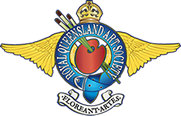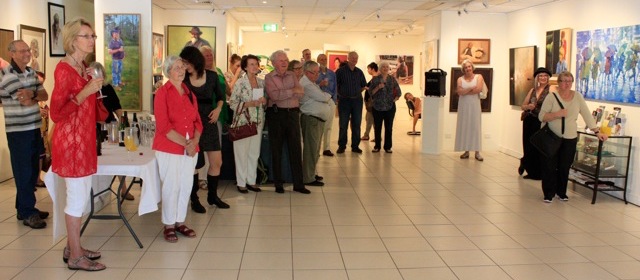Throw back Thursday!
You might all enjoy some little historical tip-bits that John Kane shared in his opening speech, that he gave a last year at out Members Annual.
I am very pleased and honoured to be asked to open this 128th Members’ Annual Exhibition.
Let me begin by acknowledging the Turrbul or Jagera People, the traditional custodians of the land upon which we stand. We pay respect to their elders past and present and extend that respect to other indigenous people who may be present.
You all know that such acknowledgements have become required at Australian openings, but I decided to look into the history of the Turrbul people to try to make mine something more than a genuflection to political correctness. To my surprise I discovered that most of what we Whitefellas know about them in the earliest days of Queensland comes from the reminiscences of a man named − Tom Petrie, after whose family the Terrace outside, and therefore this gallery, is named. A connection!Tom’s father, a Scottish builder and architect, was the first free white settler in Brisbane in 1837, building a large house at Petrie Bight by the river. Young Tom, having no white playmates, became close friends with the Aboriginal boys of the neighbourhood, learning their Turrbul language perfectly, travelling to corroborees with them (at 14 even as far as the Bunya Mountains) and learning their customs and manners. So intimate was his association over a lifetime that his daughter, Constance Campbell Petrie, thought it historically essential to publish his diaries in 1904 under the title Tom Petrie’s Reminiscences of Early Queensland (starting 1837). I was able to locate a full copy online and as a consequence spent a whole day not writing this introduction, but perusing a fascinating, touching and ultimately, one must say, tragic history of the city around us. But it wasn’t a wasted day, for my proposed acknowledgment now seemed it could be more than just a respectful formality.
So I say again: Let me begin by acknowledging in all sincerity the Turrbul People, the traditional custodians of the land upon which we stand.
Tom Petrie died in 1910, having witnessed most of early Queensland history, good and bad. I don’t know whether he had any knowledge of the event, but in 1886, when Tom was 55, a group of people interested in art formed the Queensland Art Society with the aim of establishing a Queensland National Art Gallery. They achieved this in 1895 under the able presidency of accomplished artist Richard Godfrey Rivers, thanks to donations from Rivers himself and the Municipal Council. The first Queensland National Art Gallery was opened in the upper room of the Town Hall, after which the Art Society and the Queensland National Gallery were inextricably linked. It is an important connection that many people have, unfortunately, forgotten.
The Society, like many organisations, had a chequered history thereafter. Its premises were destroyed by fire in 1912 with all records lost. Its fortunes were revived a decade later when it acquired a purpose-built gallery in George Street and received royal patronage, thus adding ‘Royal’ to its name. Thereafter some of its more notable members, Vida Lahey and Daphne Mayo, created the Queensland Art Fund to secure premises for the State gallery. They succeeded in 1931 when the Queensland National Art Gallery was established in the old Museum in Bowen Hills, where it enjoyed generous patronage.The relationship between RQAS and the Queensland Gallery continued strong with many members represented in Gallery exhibitions, but over time the RQAS suffered a decline. After a couple of moves, it found itself situated on the corner of Edward Street and Astor Terrace, by which time it had become rather inward-looking and moribund. But it survived until 2011 when its then-president Glen Gillard and some of its members, feeling the need for new space, new members and new life, sold the valuable Astor Terrace property and secured and vastly improved these premises on Petrie Terrace. As well as providing financial security, the move afforded room to house a library, kitchen, teaching rooms and multiple gallery spaces.
The transfer proved immensely successful. It resulted in a huge increase in membership, a continuous stream of exhibitions both private and official, regular art lessons and frequent workshops by eminent practitioners, incoming financial support from local government and other sources, and a general resurgence of energy and life. Important new initiatives were undertaken such as the establishment of the RQAS Biennial (and here I should give a nod to my wife, Kay Kane, who, as then president, put her full weight behind this initiative). The Biennial incorporates three exhibitions: a Figurative Art Award with a first prize of $10,000; the Harold Richardson drawing Prize; and a Young Artist Award. The last of these is particularly significant in promoting engagement with schools and encouraging and supporting young artists in the pursuit of excellence, an aim of the Society’s since its foundation.
And this brings me to the Annual Members’ Exhibition which, despite the Society’s ups and downs, has been held every year since 1886 − except for a few years during World War II when people no doubt had other things on their mind. That break, by the way, explains why this is the 128th Annual and not the 132nd. I did not attend the first Annual, but I have been present at the last 10 or so and have seen the growth in the number of artists represented and elevation in the quality of work presented. Tonight is no exception. I have been very pleased to peruse the works on display and admire both their variety and accomplishment.
I’m very glad, in fact, I was asked to open the show and not to judge it. That task was put in the able hands of Denis Brockie and Richard Blundell and I am sure all you artists present are looking forward to hearing the results of their considered deliberations.
So without further ado I declare the 2018 Members Annual Exhibition officially open, and return the podium to Margaret for the prize-giving ceremony.
Opening Speech Annual Members’ Exhibition 2018
by John Kane

